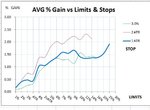rsh01
Experienced member
- Messages
- 1,184
- Likes
- 299
Fibonacci retractments Oversold Undersold Tramlines its all pie in the sky as far as I'm concerned because it rarely pans out as predicted and "rarely" will empty your account sharpish.........
In the few years I have been trading I use the old adage any profit is a good profit....
Always works for me.
Your adage is f crap. Its a vague statement which is ambiguous at best, and more importantly its not a rule in which you can follow as part of a strategy. On that basis I do not think you have a strategy either, and therefore you are merely punting - please prove me wrong. Moreso you are not even defining your exit on anything related to the market, price action (behaviour also) et al....its purely based on your pnl - which the market is obviously unaware of.
At least people using indicators are using price related, albeit lagging, tools to determine possible future actions. It also provides them with a clear rule, one which cannot be misinterpreted, so that ill-discipline/complacency/laziness can be clearly identified at the time or on a quick review of trades.
Post anaysis of trades is imo an important exercise to do when reviewing exit strategy. If you identify low drawdown on the majority of, for example, with-trend trades this may allow you to reduce your SL for these trade types, increasing your r:r.
Please can you explain what the adage means with respect to your trading - do you close out as soon as its in profit eg 1 tick in the green? Or is it 10 ticks? Or any other number which has no relation to PA? How did you calculate this to be the most effective exit point? How many years of data have you backtested/forward tested this on? So looking for areas of s / r ahead and behind of your entry is futile when deciding exit points?
Also what does 'it rarely pans out as predicted' mean? If a strategy works then it obviously pans out how they predicted enough times to make it profitable. You are talking absolute tosh.



